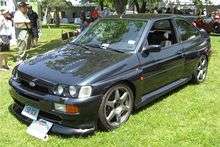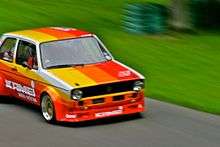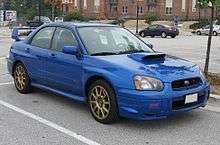Sport compact
A sport compact is a high-performance version of a compact car or a subcompact car. They are typically front engined, front-wheel drive or all-wheel drive coupés, sedans, or hatchbacks driven by a straight-4 gasoline engine. Performance-oriented sport compacts generally focus on improving handling and increasing performance by engine efficiency, rather than increasing engine size. Sport compacts often feature external body modifications to improve aerodynamics or house larger wheels.
Typical sport compacts include such examples as BMW M135i, Ford Escort RS Cosworth, Honda Civic Si, Mazdaspeed3, Renault Clio V6, Renault Mégane Renault Sport, Peugeot 205 GTI, Volkswagen Eos, Volkswagen Golf GTI, and in the USA Chevrolet Cobalt SS, Ford Focus SVT, Honda Prelude, Hyundai Veloster Turbo, Mitsubishi Lancer Evolution, Mitsubishi Eclipse, Nissan Sentra SE-R Spec V, Opel Astra GTC, Toyota Celica, Scion tC and Subaru WRX.
Tuning

It has become fairly popular to modify or customize a sport compact, commonly referred to as tuning. This has given rise to the term "tuner" for the owners of modified sport compacts (and other vehicle classes), and by extension, their automobiles. As with trucks and other vehicle categories, there is a large market for performance-enhancing equipment designed to fit small cars. Unfortunately, "tuning" is a term that is also symbolized by cosmetic and non-performance related vehicle modifications. It is the subject of some controversy whether to recognize a compact "tuner" car that has been modified to offer lesser vehicle performance than a "sport compact".
Cosmetic tuning may include changing the interior (such as changing the shift knob and steering wheel as an example) and exterior decoration, installation of a DVD combined with a powerful sound system, adding neon headlights and other aftermarket lighting systems to name but a few. Performance tuning can include the modification of the car's aerodynamics, adding a nitrous oxide injection system, changing wheels and tires, chip tuning, installation of a weighted gear knob and a short shifter, changing filters and so on.
Restoration of a Japanese import to its JDM specifications (or J-Spec) has become a fairly popular modification for many tuners in North America. It is quite common for Japanese automakers to produce or export less powerful versions of their models to the North American market. The common exception to this is the 1993-1998 Toyota Supra which received a more powerful engine for US export due to the "Gentleman's Agreement" in Japan. Such modifications usually involve swapping engines and transmissions. Popular examples include the conversion of parts from a JDM Silvia onto a USDM Nissan 240SX, or replacing JDM Honda parts and equipment (such as from a Civic Type-R) onto a United States domestic market USDM Honda Civic. Most Hondas are particularly good examples of this because of the cost saving "parts bin" designing used at Honda. To save production costs many high-end production equipment use the same or similar mounting locations as a cheaper or lower-performance alternative. These modifications can also be cosmetic, such as the replacement of the front fascia or rear spoiler with its JDM counterpart.
Motorsport

Small cars with high power ratings can be formidable racing vehicles. The Sports Car Club of America has long hosted races for compact cars. More recently, sport compacts have become so popular that the Australian National Drag Racing Association (ANDRA) (www.andra.com.au) now have special classes for sport compact racing, and the National Hot Rod Association (NHRA) has made sport compact cars eligible to compete in the Lucas Oil Sportsman Series, and Sport Compact "Pro RWD" type cars are used in the NHRA Pro Stock category as the Chevrolet Cobalt is used as the manufacturer's car in the class. All these classes are officially sanctioned by ANDRA and are recognised through a series of successful events and National Records.
Some highly modified sport compact dragsters can accelerate from 0-60 mph in less than four seconds.[1]
Sport compacts are fairly popular for autocross competitions. The Acura Integra, Toyota Celica, and MINI Cooper are some of the more successful sport compacts within their classes.
It is also worth noting that sport compact cars have been the backbone of the latest motorsport discipline to emerge - drifting - since its beginnings.
The former NASCAR Goody's DASH Series found new life in 2005 when acquisitioned by International Sport Compact Auto Racing Series (ISCARS) DASH Touring,[2] which tours primarily on asphalt ovals throughout the southeast. In 2008 the series accepted the sanction of American Speed Association (ASA).[3] The TC 2000 Championship is one of the touring car racing series which involves sport compacts.
Market trends

Sport compacts remain one of the largest segments of the performance car market in Europe and Japan, and is seeing a resurgence in North America after declining sales in the 1990s.
Japanese manufacturers such as Honda, Mazda, Mitsubishi, Nissan and Subaru have continued to release new generations of sport compacts, such as the Honda Civic Si, Mazdaspeed3, and the Nissan Sentra SE-R Spec V. General Motors and other American companies has responded with the Saturn Ion Red Line, the Pontiac G5 GT, and the Chevrolet Cobalt SS. Dodge released the Neon SRT-4 in this class, and later the Caliber SRT-4, high-performance versions of their respective models.
European manufacturers have long offered multiple high-performance compacts in Europe and many of these are imported to North America. These are called hot hatches or warm hatches depending on engine power as they are available as hatchbacks. They include the VW Golf GTI (which was first announced in 1975), Volkswagen R32 and Mini Cooper.
Econosport
Econosport is a rarely used term for a sport version of a small economy car.[4]
References
- ↑ "Superfour Challenge - - Car and Driver - November 2005". Car and Driver. Retrieved 2011-11-08.
- ↑ "ISCARS". Iscarsonline.com. 2011-03-23. Retrieved 2011-03-31.
- ↑ "ASA Racing". ASA Racing. Retrieved 2011-03-31.
- ↑ DiPietro, John (10 May 2002). "2002 Econosport Sedans Comparison Test". Edmunds. Retrieved 26 April 2013.